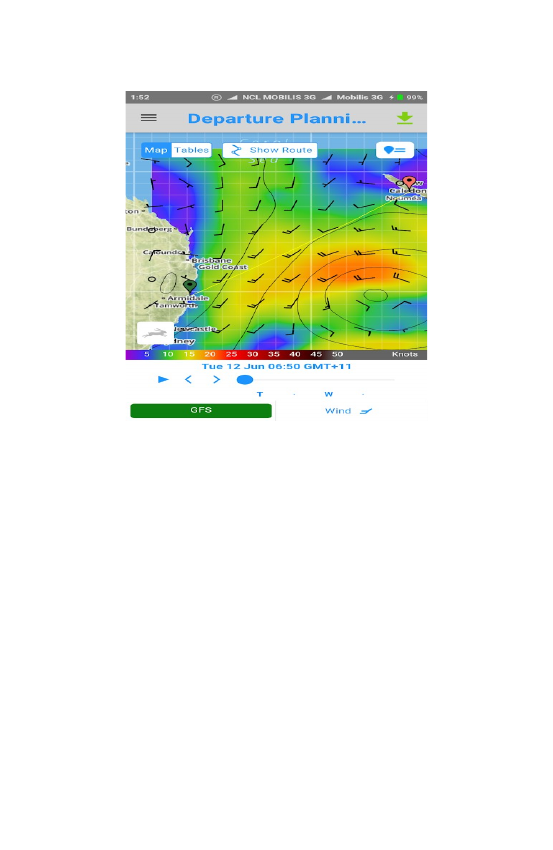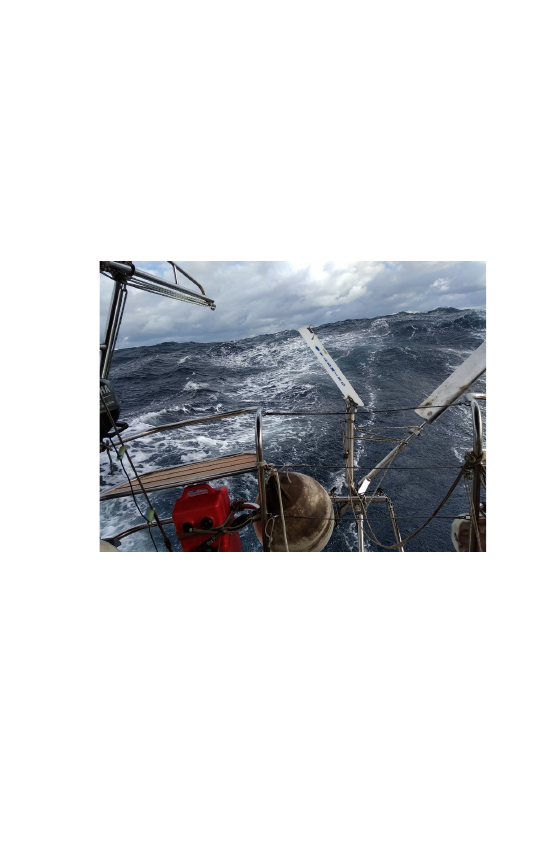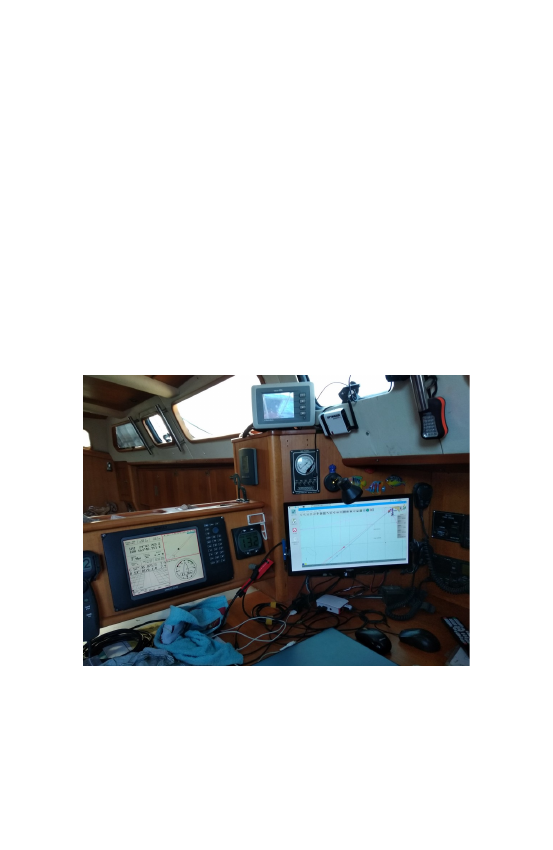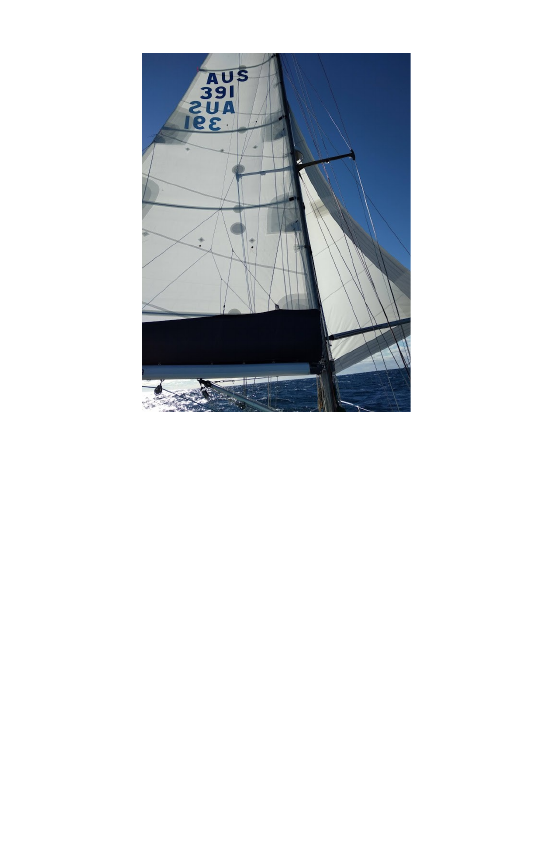
Chapter 5 Coffs Storm to
New Caledonia2018
Introduction
While cruising, particularly around the world,
one studies weather systems and becomes quite
knowledgeable about their movement and
intensity.
On Australia's east coast, the systems are highs
that develop over the centre of the continent
and move east, or lows that spin off the
Southern Ocean and move north up the coast
before heading eastwards towards New Zealand.
These lows can dissipate as they move or, in
some cases, deepen and become East Coast
Lows with intense weather systems around
them. They're dangerous because of the
gradient of the isobars (i.e., the closer they are
together, the stronger the wind), and the lower
the pressure at the centre, the stronger the
wind towards that centre.
Another factor is wind direction. On the west
side of the low (for those in the Northern
Hemisphere, our lows turn clockwise), the wind
blows westward and then towards the north. We
1

all know (from the 2003 film, "Finding Nemo")
about the large and strong East Australian
Current that originates in the Coral Sea as warm
water, hits the coast at 15 degrees S, then flows
south with its fastest speed up to 5 knots and
strongest point off Cape Byron, NSW, before
widening out near Tasmania.
When the southward-flowing current meets an
East Coast Low moving north, with wind
compressed between the centre low and the
coast at speeds from 10 to 50 knots, the open
sea can get ugly. The wind-driven swell and
resultant waves collide with the warm water
flowing south and the two forces of nature
collide. The waves become steep, their tops
tumbling down into the troughs. The backs of
the waves are also steep, and many a Hobart-
destined yacht has bashed through them to find
their boat and gear weren't up to this
rollercoaster ride.
A yacht of Malua's size must be very careful
when running before these winds in steep seas.
Go too fast, and you may speed down the face
into the swell ahead and bury your boat in
water. Loose your direction, and you may turn
side-on to the swell and waves. Alternatively, if
you travel slower than the swell, you may be
2

overcome by breaking waves and swamped by a
big one.
My strategy is to run before the wind at an
angle that keeps me moving diagonally to the
waves at a speed that I and the autopilot can
control.
When I set off from Coffs Harbour to cross the
Tasman to New Caledonia – a 7-day passage – I
had assumed the low would continue its track
towards New Zealand, and I would get
favourable winds all the way to my destination.
The low stalled and didn't move for days, and I
sailed right into the edge of the East Coast Low.
Here's what happened.
3

The Storm
Should I go today or check in after clearing
customs at Coffs Harbour? That was the
question I now faced. I had been watching the
low off the coast for a few days, and it looked as
if the low was moving as expected towards NZ,
so I decided to go. As I nosed out of the
protection of the harbour, I realised that what
looked like smooth water was not.
Now the wind was blowing from the south and
the current was running southwards – in the
opposite direction, so the ocean swell started to
get steeper and steeper while the wave tops
4

were being blown off. I had put in one reef
early, so when the wind reached 25 knots, the
second reef went in, only for a very short time
before I had to put the third reef in. I furled the
genoa to almost nothing, but it was out on the
spinnaker pole because I was now running
diagonally down the face of the waves – the
most prudent course in steep swells.
The wind instruments stopped working at 54
knots, but all was well on board.
Suddenly, the bilge alarm went off as I was at
the wheel guiding Malua down the waves, not
trusting the new autopilot. Once, then a second
time the shriek of the alarm sounded, and then
continuously with a scream that would wake the
5

dead. What was going on? Was there a hole in
Malua, maybe a thru-hull had come adrift?
Down below, I lifted the bilge hatch to taste the
water, but there was no need – the flow of water
from the stern area was more than a breached
tank would supply.
This was serious.
Maybe the shaft gland had come loose? I
opened the door into the engine compartment.
The shaft was OK, but the water flowing from
the rudder area was a stream. Oh no! Not the
rudder.
With the torch in my mouth, I climbed into the
engine room to look for the source, and there it
was running like Victoria Falls from the port
lazarette base – cascades of salt water – right
over the old autopilot. What? Why that much
water? Back outside, I looked at the water
flowing over the deck and lazarette, but that
couldn't cause that amount of water to enter the
vessel, so what was it? As soon as I opened the
lazarette hatch, I understood the situation. The
compartment was almost full of water with
containers floating on the surface. I removed a
few, and there, right in front of me, as one of
the larger waves broke and tumbled down
6

towards the stern of Malua, the white water
came over the swim platform and washed
halfway up the stern before draining away. Why
into the locker? The locker contained the two
gas bottles. A safety hole permits excess gas to
drain out onto the swim platform on the stern.
The gas drain hole is more than 20cm round, so
a wave that floods the swim platform can flow
inwards to the locker. Now under normal
circumstances, the odd wave over the stern
causes no harm or flooding of the gas locker, but
with the steep swell and the rolling waves from
their tops down the face and into Malua, well,
that was a different matter.
After repeated waves over the stern, the rate of
in-flow was greater than the out-flow from the
exit hole, and the locker started to fill. Its only
exit was down a gap in the floor created when I
removed the autopilot to fix it. I hadn't had the
opportunity to fibreglass the interior, and the
seawater drained into the interior of Malua,
setting off the bilge alarm.
I went down below to the emergency stores for
a wooden plug and hammer and back to face the
oncoming waves. I hung over the stern to put in
the wooden plug. A good tap/strike with the
7

hammer, and it would stay in place till I reached
land. After a few minutes, the bilge alarm
stopped, and all stations returned to normal
storm tactics.
At that point, I took a deep breath and went
below, put the kettle on for some hot tea, and
settled into my captain's chair as I watched the
wind go up and down to a high of 40 knots and
an average of just a little over 30 knots. Malua,
as always, handled the conditions well; the new
autopilot had a few bad calls, but what can you
expect, being so inexperienced?
It was now dark, but I could still see the white
waves behind me as we raced forward down
some of the steepest seas I have ever seen. Not
8

for a moment did I consider further reducing sail
or changing course... we were in a groove.
The day dawned with no sleep but an uneventful
night and many miles under the keel. I had
noticed that the wind was dropping, but then
again, it may have been that it was daylight, and
that made the conditions look a bit better. After
a few more hours of steadily declining seas and
wind, we were back on track for a smooth
passage to New Caledonia.
I have been in a few storms in my time, from a
very bad one off Cape Point in Cape Town to the
knockdown a few days out from Tonga and one
on passage to New Zealand, but this was the
most severe with the steepest waves, though
not the strongest winds. Thankfully, it lasted
just over 12 hours, which is quite bearable
considering.
9

The balance of the trip was very easy, with the
sun coming out and the wind dropping on some
occasions, which required I start the engine. I
was able to time my arrival for dawn to go
through the pass and motor towards Noumea
city and marina. I made the mistake of telling
the marina I was not going to stay with them, so
I was relegated to the back of the line for
clearance and, in fact, had to be boarded by Bio-
security at the public wharf in the SW - not
convenient. I did stop for fuel at the end of the
jetty and some bread, then off to the Orphelinat
Bay anchorage to get the tender ready to do the
10

rounds to clear in. A simple process requiring a
few km on my folding bike.
Restock and ready for Denny to fly in for a few
weeks cruising these delightful islands.
COVID interrupted my cruising plans and Malua
did not get the attention all yachts deserve
during that period. However when all was
shipshape and it got cold in the winter I sailed
north to warmer weather. The trip home had
some surprises in store.
11










